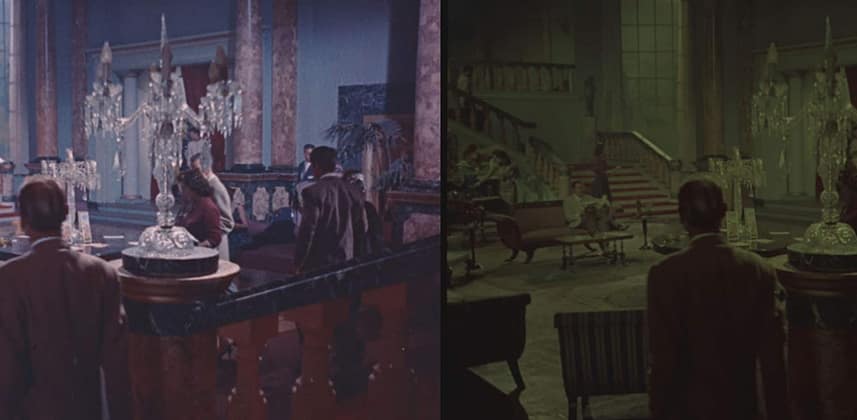Day 9: 24 Insights in 24 Days 2018 New Year Marathon
Team Mixing Light Note: This is the first Insight on Mixing Light from Colorist Jim Wicks. Not only does he spend considerable time restoring classic films, he is the Managing Editor of the weekly Tao Colorist Newsletter and is a co-founder of Colorist Society International. Feel free to welcome Jim in the Comments! You can read more about Jim on our About Us page.
Introduction: My Background As A Colorist
Before we dive into my work color restoring classic Spanish-language films, since I’m new to Mixing Light readers I’d like to introduce myself with a few words on who I am, who I work for, and how we (the films and me) got here.
Supervising DI Colorist
For 7 years I have held the title of Supervising Digital Intermediate Colorist and Manager of the Color Department at Olympusat Entertainment, based in West Palm Beach, Florida. During this time I worked on hundreds of classic motion pictures.
Olympusat is a unique company. In addition to being one of the largest production and post-production houses, it also owns, operates, or manages over 50 OTT television channels. Most are Spanish language, a few are English, and some are religious. In 2011 the company, which is privately held, made the decision to do for Spanish-lanauge classic films what Criterion, Hollywood, and others have been doing with classic English-language films: Olympusat made the decision to color restore culturally significant films from the Golden Era of Mexican Cinema.
Color restoration isn’t our only work. My department color grades a wide variety of media: new commercials, promos, movie trailers, and original movie and television productions. Most of these are shot in-house by our production crew using RED Dragon. Color grading services are also available to clients who hire my team to color grade their projects.
But, color restoration is altogether a different kind of animal. And, baby! It’s the kind of work that can break you; it ain’t for the faint-hearted, definitely not for everybody. More on that in a moment.
Before proceeding further, I want to give a shout out to my colleague, Mario Pantin, who has worked with me since 2014. Mario is one of the best colorists I have had the pleasure to work with. We share a love of classic motion pictures, and continually riff off each other’s work. It’s a fun atmosphere where the films, and the audience, are the winners.
Restoring Classic Mexican Films
I have had the pleasure of working on the projects created by the A-list of classic Mexican filmmakers. Unfortunately, most, if not all of these great artists have all passed on. But their work and artistry still live with us, on 35mm film.
Not to get mystical about it, but I feel their presence over my shoulder while I work on their films – and I take the responsibility seriously.
My clients are the greatest stars of Mexican Cinema: Pedro Armendariz, Maria Félix, Silvia Pinal, Germán Valdés, and the legendary Santo. They include the best directors: Roberto Gavaldón, Luis Buñuel, Juan Orol, and many more. And the films span all types of genres: musicals, film noir, drama, horror, comedy, and many, many more.
The Pipeline: Restoring Classic Films
Olympusat is a vertical media company. Much like Apple, we do everything in-house. This means only Olympusat employees work on the restoration and preservation pipeline, there are no 3rd party vendors involved. The company owns the movies, owns the restoration, and owns the distribution – by way of over 50 cable channels. But with these films, it all starts in their home country, Mexico.
Scanning In Mexico City
Many of the films are culturally significant and cannot, by law, physically leave Mexico. Company employees in Mexico City do all the scanning; from 35mm into 2K uncompressed DPX image sequences as well as all repair nesssary to clean up the original film. An entire movie fits on a 2TB SATA hard drive. Those hard drives are sent to me in West Palm Beach for color restoration.
A majority of these films were never properly cared for. The result is that the films have been ravaged by time, and by the elements. That said, no film can ever truly escape damage even when stored properly, as director Steven Spielberg discovered:
“The negative of Jaws was pretty crummy. Pretty bad.” – Steven Spielberg talking about his classic 1980 film, Jaws, which was stored in Universal’s film vault.
Unlike Jaws, many of the films that come to my team were not stored in vaults; they were stored in attics, old storage trunks, and even a garbage bag or two. So, if a 1980 classic like Jaws – which was stored in a humidity controlled film vault was “pretty crummy” – you can imagine what I see when I load a 1940’s or 1950’s film in my color suite!
Watch: About The Restoration Of Jaws
The Workflow: Grading In ACES
The stills I’ve pulled for this Mixing Light Insight are from 2K uncompressed DPX frames from the 1958 musical melodrama Cuando Mexico Canta. All screen captures are courtesy Olympusat Entertainment.
Evaluating The Original Scan
This frame is direct from the scanner, no color adjustments are added. This is what I see when I load the film into DaVinci Resolve Studio (my grading monitor is an FSI CM250). The film is dark, and looks as though it has been dipped in can of dark green paint. Lights? Camera? Action? Where is the detail?
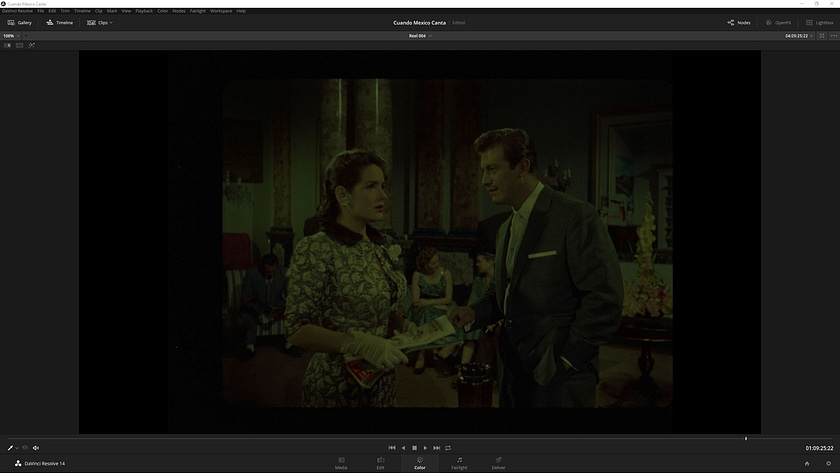
The scopes confirm what my eyes tell me; luminance is practically non-existent. Green is the dominant color. Red and blue are present, but severely diminished.
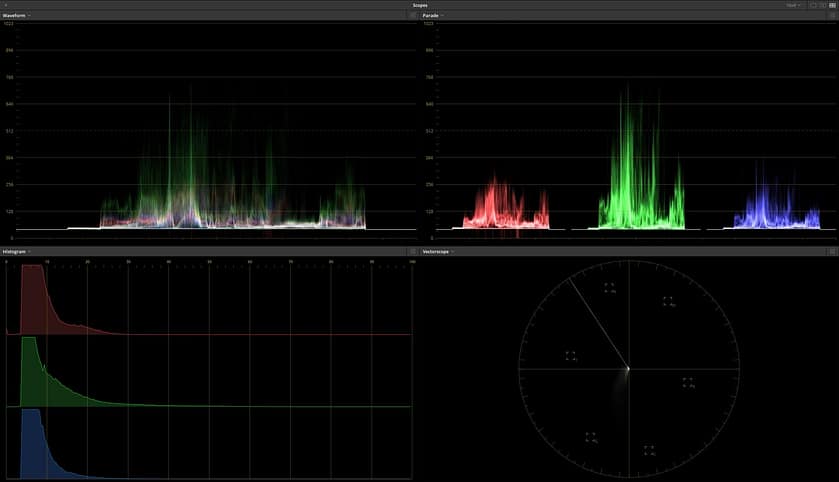
This is the same frame, after color restoration using the ACES color management system. Quite a significant difference, don’t you think? I’ve really come to trust and rely on ACES and I’ll explain why in more detail later in this Insight. I think you can see that the restoration work breaths life back into the film.

This is what the film looks like in scopes after my work. Luminance has been restored. The RGB levels have been brought back in proper order to help give the film it’s full, vibrant, lush look.
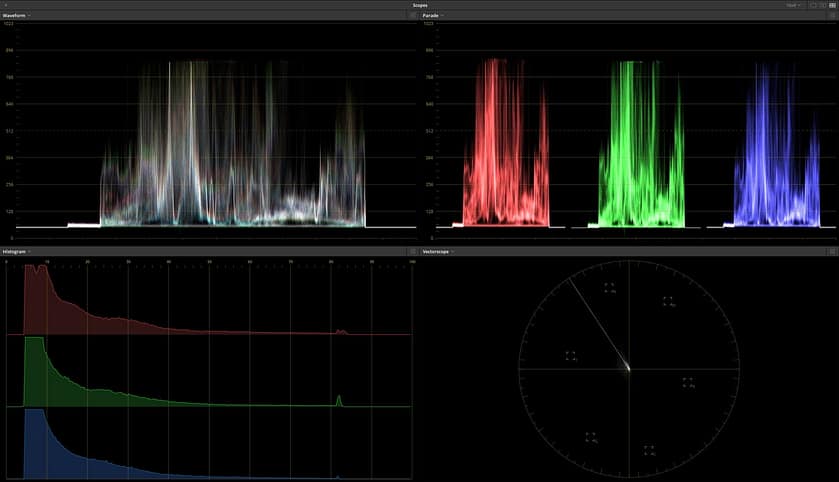
Project Setup
Below are my settings in ACES, which can be found in the Color Management tab of Project Settings.
For this film, I am using ACEScc set to version 1.0.3. The IDT (Input Device Transform) is set to ADX 10 – ADX stands for Academy Density Exchange, the 10 stands for 10bit. ADX 10 and ADX 16 (16bit) are the correct IDTs for scanned film content to be used in ACES
The Output Color Space is Rec.709. This is my common starting point for these classic films and is one of the few choices I make that doesn’t change much from film-to-film. The final output will be shown on television only. This film is not slated to be made into a DCP or to be streamed online. The ACES Rec.709 IDT uses a gamma of 2.4.
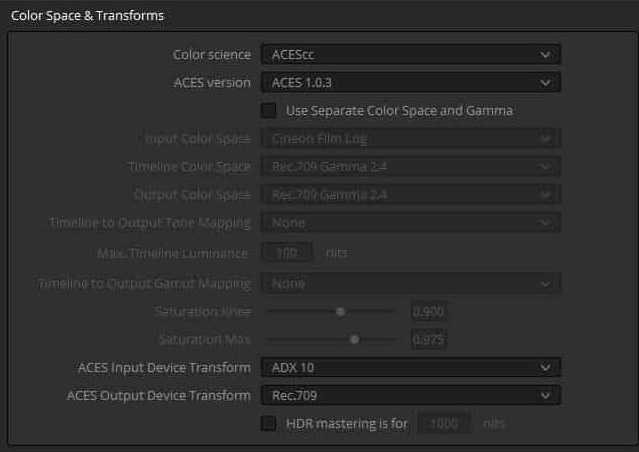
Why ACES?
For me, ACES helps with the heavy lifting. Since ACES is designed for professional filmmakers and leans heavily on a photochemical heritage dating back over 100 years with film-originated restoration, ACES creates an amazing starting point for my work. Images that I might struggle with using the default DaVinci YRGB processing, I find when I start these projects in ACES, they become much more pliable – the images feel much more organic and I start with more latitude for subsequent adjustments.
ACES Is Just The Starting Point
But as much as ACES is a great starting point, there’s still a lot more work to be done. And in DaVinci Resolve that work is represented by nodes and the corrections you do on them. Below is a quick explanation of what I’m doing in these nodes:
- Node 1: I always leave the first node blank. It’s a habit I picked up from my senior colorist when I was just starting out years ago. It’s a ‘just in case’ node ready for ‘digging in’ before all my other adjustments, and keeps the tree neat and tidy.
- Node 2: This is where I open up the film to see how much luminance latitude the film scan is giving me.
- Node 3: This is the preliminary color balance. I use DaVinci’s LOG controls in combination with the Splitter/Combiner to get down deep into balancing the color.
- Nodes 6, 7, 8: These nodes are the output of the Splitter Node. As its name implies, it splits the signal into the three primary color channels – Red, Green and Blue – and feeds each color channel into a single node (Node 6, 7, 8, respectively). Once split, I massage each color channel independently before combining them back together with the Combiner Node.
- Node 9: This last node is where I finish up, adding my ‘secret sauce’ to help bring back that cinematic look from the 1950s. What exactly is the secret sauce? It’s a series of actions that I have developed through trial and error over the course of my career that adds the final polish to the film. What’s the recipe you ask? That’s another Insight for another day. No worries, I have more insights I’m sharing today, so stay with me.
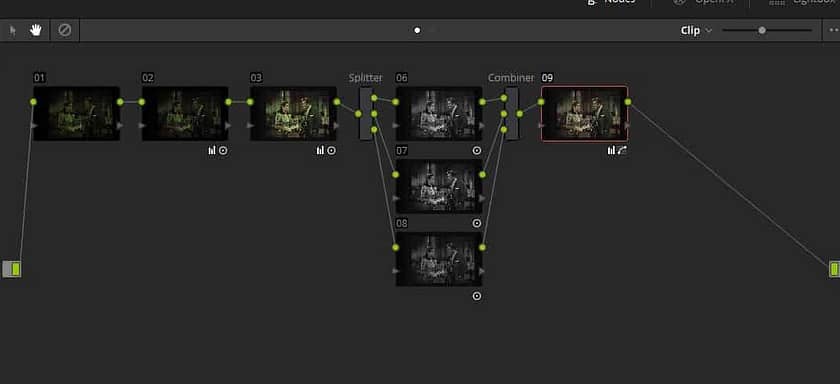
For this film, this node tree represents a fairly straightforward correction. It’s a series of broad, primary corrections and no secondary work. But avoiding secondaries presents its own tough challenges.
Extreme Grading: When The Going Gets Tough
Film restoration/preservation is not easy. Successfully restoring the shot we just looked at, without pulling secondaries, might make you feel like King of the Grading Suite. But pride comes before a fall.
That ‘high’ quickly dives into despair because no matter how good you think you are, these films beat you up. A number of colorists left my team because they just couldn’t wrap their minds around color restoration.
I like to say that these films pound on you like a boxer on Saturday night. I don’t think it’s an understatement to say that color restoration is some of the toughest color work you’ll ever do – and the toughest work you’ll ever do well.
If you are used to working in commercials, features, episodics, etc., classic films like these have challenges you have never faced. Conversely, if you learn to do this type of work well, then you can handle just about anything! And dealing with film opticals is a good example of what I’m talking about.
Film Opticals: The Colorist’s Mt. Everest
Back in the day, opticals (the film equivalent of visual effects) were created using optical printers.
This was the process they used to make fade-ins and fade-outs, cross dissolves, title and credit sequences, mattes, etc. They were usually exposed on specialty film stock different than the rest of the film. In my experience, film opticals are the first element to deteriorate; usually at a faster rate than the rest of the film.
60 years ago, even when this film print was new and clean, the edit point from the negative to the optical negative probably didn’t match. As time passes and the print deteriorates, these match points get ridiculously mismatched. Cuando Mexico Canta has a perfect example of this challenge.

In the screen capture above, you can see on the left the last frame from the fade-in of the optical negative. On the right is the match frame to the first ‘good’ frame of the film. No color correction added. You are seeing what I see as it came to me directly from the scanner.
This is fairly typical of the damage I see – it’s with fades, dissolves, and opening title sequences. As a colorist, in these quick optical transitions I’m grading an altogether different piece of film print than the body of the motion picture – and my job is to get the two as close to a perfect match as possible.
Climbing The Optical Print Mountain
Below is my final match between those two frames, trying to get as seamless a visual match frame edit as possible.
To the colorist’s well-trained eye, you notice these frames still have a slight color shift, but they are much closer overall. The walls on the left are a little cooler than on the right.
This same mismatch on an Arri Alexa originated film would be unacceptable. But we rarely, if ever, get opticals to perfectly match the body of the film – for a 60 year old film, this is as close to a bases-loaded triple play as you’re likely to get.
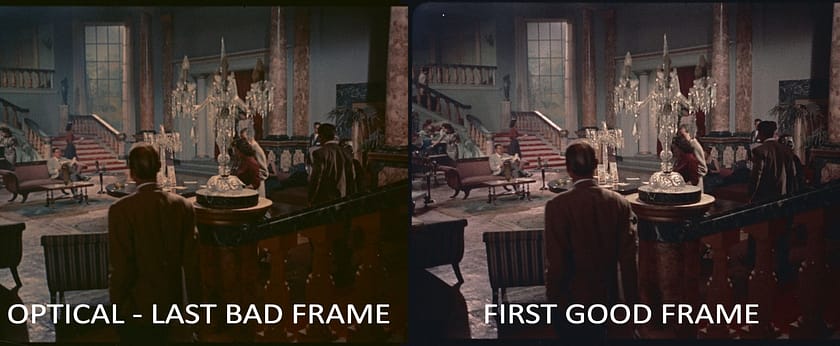
Did I Mention The Slow Color Shift?
What you don’t see here, as this optical fade plays there’s a color shift coming out of black. So once the two frames at the match point are color corrected and aligned, another overall correction to the optical transition has to be made. Or does it?
You might be tempted to keyframe a broad primary correction to account for this fix. Or, you can quickly try to add your own faster ‘digital’ fade from black on top of the optical fade. That’s what I do. The net result was the new fade helps ease the viewer into the body of the film without a jarring color shift – and gets me finally moving to the next shot, no keyframing necessary.
Closing Thoughts
Here’s one awesome secret to my work that I will let you in on: Every film I work on is already color timed.
I’m always working from a final print (not original negative, which is long gone). In the case of Cuando Mexico Canta, this timing happened 60 years ago (as of 2018). Film color timers are the forerunners of modern colorists and technically, they’ve already done our work for us.
Those of us in film preservation don’t have to re-invent the film into what we think it should look like. In the role of a restoration colorist, my job is to honor the vision of the work done by the artists who came before me.
But here’s another no-so-fun secret: My workflow for this film is a one-off. My solutions on this film only work for this film. They will not have the same effect on the next film. Saving off Node Trees to re-use on subsequent films just doesn’t work. I wish they did!
The next film I work on has its own problems and requires it’s own customized solution. Translation? With every new film I start from the beginning: Analyzing the scan and searching for new solutions to the problems of that specific film (which deteriorated in its own special way).
And here’s an answer to a question I’m frequently asked: While I do pull secondaries, overall, the ratio is nowhere near what you and I do on modern features. Plus, there is no metadata as with RAW in RED or ARRI to make further adjustments at the ‘camera negative’ level. The biggest thing I have going for me on these projects: The cinematic look is baked into these film prints.
So, What Makes An Image ‘Cinematic’?
It’s another question I get asked all the time. Here’s what I know: In my experience with film restoration, ACES is the best tool in my utility belt to help me restore and preserve classic films. ACES helps me bring back the look of a film that time has all but destroyed.
On a technical level, however, I could not begin to tell you what a cinematic look is or isn’t. I’ve been working in motion pictures and television for more than 40 years, and watching films ever since I was a kid in the 1950s. So I guess all I can say is: I know cinematic when I see it.
If you have questions or more to add to the discussion, please use the comments below
Cheers, J
Postscript: A Classic Color Grading Story
In this Insight I’ve shared with you an overview of my film restoration process and challenges. I thought as a postscript I’d share a quick story about my role as a restoration colorist:
A producer of some of the classic movies I work on visited my color suite to sit in on a session. From behind me, he made a very complimentary remark:
“You’re taking more care to color restore this old film than we took when we made it.”
This same producer then taught me why some classic films sour on me, unpredictably. For years, I’ve noticed that one scene might respond as if it were shot yesterday, while the immediate next sequence inexplicably fights me every step of the way.
This visiting producer saw this phenomenon happen to me and let me in on a little-known production secret… Back in the day, when a production ran out of negative to shoot with (which he said happened frequently) the crew starts scrounging around looking for any unexposed negative they can get their hands on. The results were unpredictable.
Sometimes the crew found ‘short ends’ from another lot of film. Sometimes the negative came from an altogether different source; which meant a different lot of negative or different manufacturer of film. The upshot: Even non-opticals negative can be completely different from the rest of the film – and at random, unpredictable times.
Film Restoration Forces Us To Throw Away Our Expectations.
The producer’s insight surprised me, to say the least. During film’s heyday, long before the advent of digital production, I assumed the DoP was responsible for ensuring that enough film stock was purchased to complete the film. After all, it’s vitally important to the look of the film that all the film stock match.
But in Mexico, the availability of film negative was not what it was in the United States, apparently. Whatever the reason for the shortage: It is what it was. Making my job today: It is what it is.
The Lesson Learned: Fix It On Set.
We need to continue learning from the past. Otherwise, filmmakers will continue pushing small problems down the pipeline until they become bigger (and more expensive) problems for us in post: no matter what decade or century you’re in.
It’s the same then and it’s the same now.

